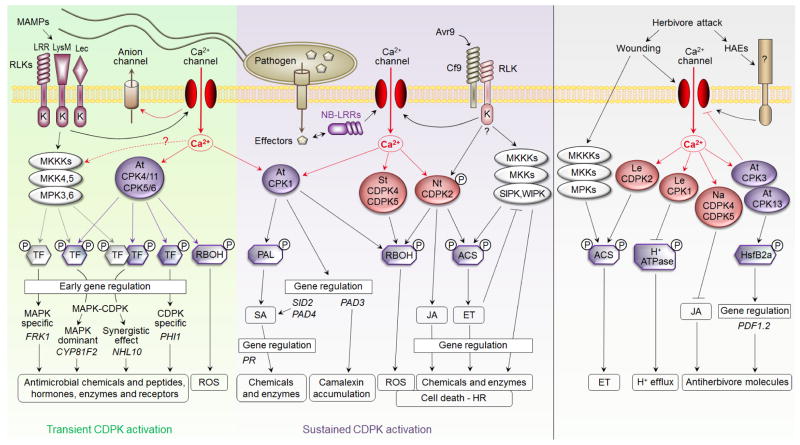Figure 2.
CDPK signaling network in immune responses. Microbe-associated molecular pattern (MAMP) perception by different cell-surface receptor kinases (RLKs) with distinct extracellular domains triggers transient CDPK activation to regulate transcription factors and early gene expression either independently or in coordination with MAPK cascades. Several CDPKs also activate NADPH oxidases (respiratory burst oxidase homologs, RBOHs) to induce early reactive oxygen species (ROS) production. By contrast, the sustained CDPK activation by extracellular (Avr9) or intracellular effector proteins leads to biosynthesis of salicylic acid (SA), jasmonic acid (JA) and ethylene (ET) through regulatory gene induction or enzyme activation such as phenylalanine ammonia-lyase (PAL) and ACC synthase (ACS). CDPKs also trigger a prolonged oxidative burst involved in cell death and hypersensitive response (HR). Constitutively active NtCDPK2 inhibits MAPK [salicylic acid-induced protein kinase (SIPK) and wound-induced protein kinase (WIPK)] activation by Avr9–Cf9 in an ET-dependent manner. Herbivores can be sensed through wounding or herbivore-associated elicitors (HAEs) by unknown receptors to activate MAPKs and Ca2+ influx. The co-regulation of ACS by MAPKs and CDPKs leads to ET production, whereas LeCPK1 inhibits the plasma membrane H+-ATPase to induce extracellular alkalinization. AtCPK3 and AtCPK13 mediate herbivore-induced gene expression by phosphorylating the transcription factor HsfB2a whereas only AtCPK3 negatively regulates Ca2+ channels. NaCDPK4 and NaCDPK5 negatively regulate defense against herbivores by inhibiting JA accumulation and subsequent production of defense metabolites. Abbreviations: MKKs, mitogen-activated protein kinase kinases; MKKKs, mitogen-activated protein kinase kinase kinases; MPKs, mitogen-activated protein kinases; TF, transcription factor.

